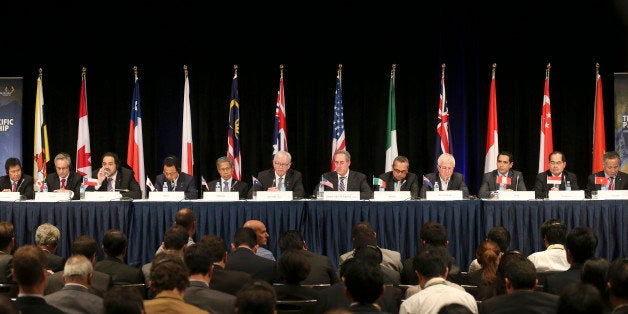
By: Lilac Nachum
The Trans-Pacific Partnership (TPP) is about to become a reality. The deal still has to be formally approved and ratified by the 12 participating countries, but the first milestone has been achieved and the odds of the Partnership eventually coming into effect appear high.
If ratified, the TPP will become the world's largest trade deal, bringing together countries that collectively produce 40 percent of the world's GDP, and representing cross-border economic activity in a magnitude double that of NAFTA.
A deal of this magnitude and scope changes the competitive reality confronted by firms across industries. It opens up new opportunities for the firms that are able to put in place the necessary strategies to take advantage of them. It also confronts firms with new challenges and may put some of them out of business. It creates new winners and losers.
The new winners will stand out from the losers in their explicit recognition of the new competitive landscape created by the TPP, and in their ability to reevaluate and revise their strategies for this new reality. While the scope of strategic reconsideration is vast, five strategic choices require special attention.
1. Rationale for global expansion
With the abolition of trade barriers and the removal of other restrictions on cross-border transactions -- the partnership would end more than 18,000 tariffs that the participating countries have placed on US exports -- domestic firms might find it economical to locate their production in (or outsource from) one of the member nations to the agreement. One reason for such moves might be the opportunity to take advantage of low cost production, and then export the output back for sale in the domestic market. The deal would also spur a renewed rationale for overseas activity in markets that were previously closed altogether for foreign companies. The removal of Japanese regulations that for decades have kept some American-made autos and trucks out of this country is a case in point. Yet another feature of the TPP that could tilt the balance towards global expansion is the establishment of uniform rules on intellectual property. This reduces a major obstacle for the movement of production and R&D overseas, notably for firms operating in industries that are sensitive to violations of intellectual property rights.
2. Choice of global locations
Trade agreements create a sharp divide between members and non-members to the agreement, and in doing this modify their relative attraction as location for business activity. The removal of barriers among the member nations make them more attractive, but exclude non-member nations. The TPP would thus divert economic activity away from non-members, and make the 12 members of the agreement -- Canada, US, Mexico, Chile, Peru, Japan, Vietnam, Malaysia, Brunei, Singapore, Australia and New Zealand -- more attractive locations for each other. For instance, other things being equal, as a member, Japan is more attractive for US firms than South-Korea (a non-member). Likewise, as members to the TPP, Chile and Peru offer greater opportunities for Mexican firms than non-member Argentina. And as the TPP is to become 'the new NAFTA', some of the current advantages of Canada and Mexico for US firms are diluted as they will be shared with the other TPP member nations. These changes require reconsideration of a firm's country portfolio and a reevaluation of the advantages and disadvantages of the existing locations in the portfolio in light of their status - as members or non-members - in the TPP.
3. Choice of entry mode
The opening of borders and the elimination of tariffs remove a major rationale for foreign investment as a means of circumventing trade barriers, and increase the attraction of export. At the same time, protection of intellectual property rights, improved labor standard regulations, and the opening up of previously closed industries and activities for foreign companies, which are part of the TPP, eradicate many obstacles for foreign investment, and increase its attraction over export. The less demanding rules regarding local contents (which mandate the share of locally-sourced input by investing firms) likewise increase the attraction of foreign investment. These developments change the advantages and disadvantages of export and foreign investment and call for reconsideration of choices made in the pre-TPP era.
4. Organization of the production
The reduction of tariffs increases the rationale for what is known as "vertically integrated production systems," whereby companies locate (or outsource) value creation activities in different locations, in line with their respective comparative advantages, with each specializing in a particular activity towards the creation of a final product. Low barriers to trade are essential for such a production mode to be economic because it generates large amounts of trade among sub-units of the firm. In addition to the elimination of tariffs and other barriers, the TPP is attractive for such arrangements because it brings together countries at different stages of economic development and varying areas of specialization. The diversity of its members is a distinctive attribute of the TPP, which is of particular value for a vertically integrated organization of the production.
5. Competition strategy
Trade agreements change the competitive reality confronted by companies. They create a level playing field among member nation companies in terms of the regulatory environment that dictates their behavior within countries and across them. The opening of markets and the removal of many differences across them creates a large market for insiders, and awards them the opportunities to take advantage of economies of scale. This new reality may put smaller and less efficient companies at a disadvantage and lead to consolidation of the surviving companies, so that they can more effectively benefit from the size of the market. At the same time, trade agreements put outsiders at a competitive disadvantage and may drive many of them out of the market. These anticipated changes call for a rethinking and redesigning of a competition strategy that is responsive to this new competitive dynamic.
The TPP, if comes into effect, will substantially modify the rationale of many strategic choices undertaken by firms, notably those pertaining to the global arena. To benefit the most from the deal, companies will have to re-evaluate choices made previously regarding their global involvement, location portfolio, the mode of serving foreign markets, the way they organize their production, and the new competitive landscape.
The stakes are high, and so will be the rewards. The winners will be those who take into account the new reality and revise their global strategy accordingly. Although the deal is still in the making, and its outcome is not certain, the strategic considerations alluded to above require long-term thinking and thorough preparation. The time to start is now.
--
Lilac Nachum is a Professor of Globalization and Management of Multinational Companies at City University New York, and holds visiting positions in business schools around the world. She offers executives a compass to navigate successfully in a global world and helps them identify opportunities for their companies. To learn more on how she assists firms to go global follow her on LinkedIn and Twitter, or contact her directly at Lilac.Nachum@baruch.cuny.edu
